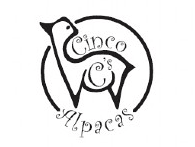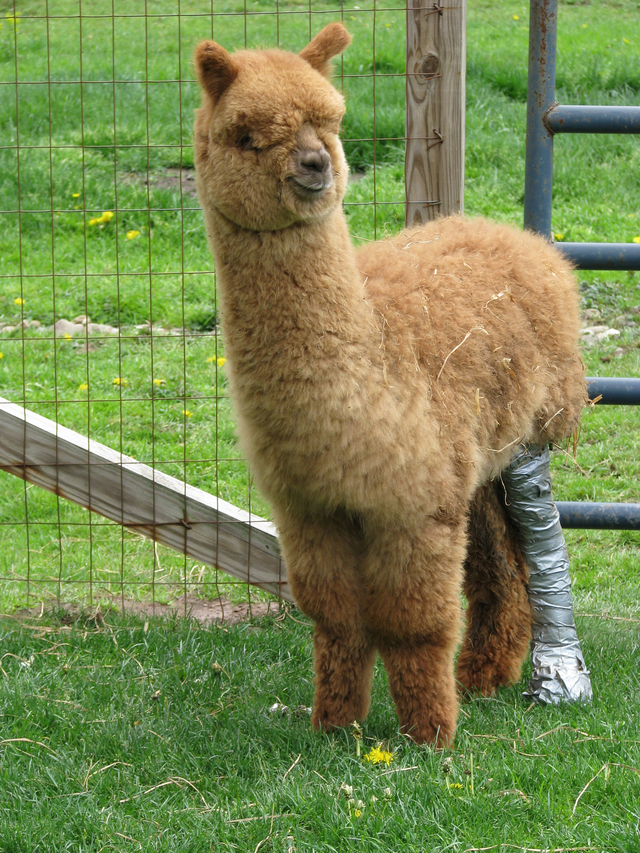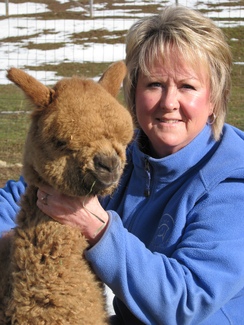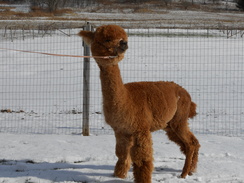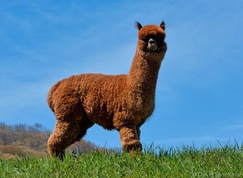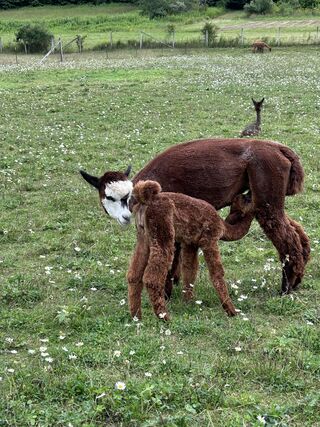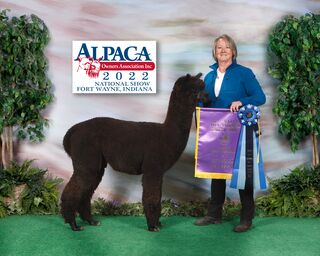Rickets??? Are you kidding me???
On a bright, but brisk morning last October our last cria for 2011 was born. A beautiful female who showed the promising traits that we had anticipated from that particular combination of genetics. Although the dam was a first time mom, she was patient with the cria as she began trying to nurse. Over the next days and weeks the cria grew slowly but did continue to gain weight. In fact, even though she was the smallest and youngest she was the leader of the evening cria pronk. She had a habit of kicking her back leg and tossing her head as she sprinted away whenever someone approached her. She is one of those crias with a very confident attitude.
I weigh our crias regularly and continued to watch her grow until she was about 7 weeks old. At that point her weight stalled. At about the same time I noticed that one of her back legs was horribly cow-hocked and I knew it hadn’t been that way before. Following two more days of observation with no change, I called my vet to have her evaluate this cria. After manipulation and observation the vet recommended x-rays. She suspected that there was a fracture. Two days later we were at Cornell University where she was evaluated and x-rayed. The x-rays revealed a fracture in the growth plate in the head of the femur. The doctor at Cornell recommended three courses of action. 1. Do nothing, which would likely result in an arthritic painful joint and an alpaca with a limp. 2. A Femur Head Ostectomy (FHO). In which they cut the head of the femur off and replace it in the hip joint to form scar tissue. I was told the end result would also be a pain-free joint. This procedure has been successfully used in small animals weighing less than 80 pounds. They weren’t sure if this joint would hold if Chanel grew larger than 80 pounds. (My thought– If she didn’t grow larger than 80 pounds, I couldn’t breed her anyway.) Cost: approximately $2500 and assuming there were no complications. 3. A procedure that would utilize stainless steel screws to hold the fractured bone in place while it healed. Cost: approximately $5000 and there was a high risk of infection and an extended recuperation period. Wanting to consult my own veterinarian we left Cornell University that evening (days before Christmas) without making a decision.
The next afternoon I received a call from the vet at Cornell informing me that they had used Chanel’s case in their Grand Rounds that morning. Upon further evaluation of the x-rays they were suspicious of a vitamin deficiency and possibly Rickets. She recommended that we do some bloodwork to see if there was an underlying condition that caused this break. It would not be wise to do any type of surgery if this cria was not otherwise healthy.
The Friday before Christmas Dr. Tanner drew the blood sample and prepared it for shipping to Cornell. The timing was unfortunate since the blood sample was not evaluated at Cornell until almost a week later due to the holiday. The chemistry panel did reveal some abnormal levels and the sample was sent to Michigan for the Vita D testing. My vet, being a relative newcomer to alpacas was unsure of the significance of the abnormalities and their relationship to alpacas. With her permission I send the report to Dr. Norm Evans and asked for his opinion. He indicated that the abnormalities did indicate that Rickets was a very real possibility and he was anxious to see the Vita D report.
While waiting what seemed an eternity for the Vita D result, I recalled Dr. Robert VanSaun’s lecture from our PAOBA educational weekend in 2010. In that lecture he spoke of Rickets and Vita D levels. After checking my notes from that lecture and being very suspicious of a low Vita D level, I decided it couldn’t hurt Chanel to administer Vita D. Since the blood had already been drawn, it wouldn’t change anything at this point except to increase her Vita D. I also administered NutriDrench orally twice daily. When the report came, indicating a Vita D level of 5, I immediately forwarded it to Dr. Evans. His response was “This is the lowest vit D level I have ever seen. Very critical. Previous low was 15. Like to see my crias at 250-300” He recommended a vita D injection even though he doesn’t usually like the injectable due to reactions. “Consider another blood 10-14 days after the shot and 2 oral doses and then go from there.” Fortunately, I had already administered the injection based on Dr. VanSaun’s protocol and by this time it had been two weeks to the day. A call to my vet, Dr. Tanner, brought her to the farm to draw another sample to see if we were making progress. (Thank God I hadn’t waited to get the report since it was now three weeks later.) Throughout all this waiting we still had a three month old cria with a broken hip!!!!!
Dr. Tanner recommended immobilizing the hip to allow it to heal. The joint was immobilized for two weeks and Chanel got along just fine on three legs. After two weeks we decided to assess her progress without support. She immediately used the leg and walked with only a slight limp.
After another three week wait we received her Vita D report and it showed the level had increased to 230. What a remarkable improvement!!!!! Just last week (Feb 20’s) it warmed my heart to see her in a sunny pasture, chasing a chicken.
Chanel will probably always have a bit of a limp, but she is alive and growing normally again. I’m so grateful for the educational experiences I have taken advantage of and the experts in the camelid field who are so willing to offer their expertise and guidance. Most of all I appreciate Dr. Tanner for her guidance and support through this ordeal.
I weigh our crias regularly and continued to watch her grow until she was about 7 weeks old. At that point her weight stalled. At about the same time I noticed that one of her back legs was horribly cow-hocked and I knew it hadn’t been that way before. Following two more days of observation with no change, I called my vet to have her evaluate this cria. After manipulation and observation the vet recommended x-rays. She suspected that there was a fracture. Two days later we were at Cornell University where she was evaluated and x-rayed. The x-rays revealed a fracture in the growth plate in the head of the femur. The doctor at Cornell recommended three courses of action. 1. Do nothing, which would likely result in an arthritic painful joint and an alpaca with a limp. 2. A Femur Head Ostectomy (FHO). In which they cut the head of the femur off and replace it in the hip joint to form scar tissue. I was told the end result would also be a pain-free joint. This procedure has been successfully used in small animals weighing less than 80 pounds. They weren’t sure if this joint would hold if Chanel grew larger than 80 pounds. (My thought– If she didn’t grow larger than 80 pounds, I couldn’t breed her anyway.) Cost: approximately $2500 and assuming there were no complications. 3. A procedure that would utilize stainless steel screws to hold the fractured bone in place while it healed. Cost: approximately $5000 and there was a high risk of infection and an extended recuperation period. Wanting to consult my own veterinarian we left Cornell University that evening (days before Christmas) without making a decision.
The next afternoon I received a call from the vet at Cornell informing me that they had used Chanel’s case in their Grand Rounds that morning. Upon further evaluation of the x-rays they were suspicious of a vitamin deficiency and possibly Rickets. She recommended that we do some bloodwork to see if there was an underlying condition that caused this break. It would not be wise to do any type of surgery if this cria was not otherwise healthy.
The Friday before Christmas Dr. Tanner drew the blood sample and prepared it for shipping to Cornell. The timing was unfortunate since the blood sample was not evaluated at Cornell until almost a week later due to the holiday. The chemistry panel did reveal some abnormal levels and the sample was sent to Michigan for the Vita D testing. My vet, being a relative newcomer to alpacas was unsure of the significance of the abnormalities and their relationship to alpacas. With her permission I send the report to Dr. Norm Evans and asked for his opinion. He indicated that the abnormalities did indicate that Rickets was a very real possibility and he was anxious to see the Vita D report.
While waiting what seemed an eternity for the Vita D result, I recalled Dr. Robert VanSaun’s lecture from our PAOBA educational weekend in 2010. In that lecture he spoke of Rickets and Vita D levels. After checking my notes from that lecture and being very suspicious of a low Vita D level, I decided it couldn’t hurt Chanel to administer Vita D. Since the blood had already been drawn, it wouldn’t change anything at this point except to increase her Vita D. I also administered NutriDrench orally twice daily. When the report came, indicating a Vita D level of 5, I immediately forwarded it to Dr. Evans. His response was “This is the lowest vit D level I have ever seen. Very critical. Previous low was 15. Like to see my crias at 250-300” He recommended a vita D injection even though he doesn’t usually like the injectable due to reactions. “Consider another blood 10-14 days after the shot and 2 oral doses and then go from there.” Fortunately, I had already administered the injection based on Dr. VanSaun’s protocol and by this time it had been two weeks to the day. A call to my vet, Dr. Tanner, brought her to the farm to draw another sample to see if we were making progress. (Thank God I hadn’t waited to get the report since it was now three weeks later.) Throughout all this waiting we still had a three month old cria with a broken hip!!!!!
Dr. Tanner recommended immobilizing the hip to allow it to heal. The joint was immobilized for two weeks and Chanel got along just fine on three legs. After two weeks we decided to assess her progress without support. She immediately used the leg and walked with only a slight limp.
After another three week wait we received her Vita D report and it showed the level had increased to 230. What a remarkable improvement!!!!! Just last week (Feb 20’s) it warmed my heart to see her in a sunny pasture, chasing a chicken.
Chanel will probably always have a bit of a limp, but she is alive and growing normally again. I’m so grateful for the educational experiences I have taken advantage of and the experts in the camelid field who are so willing to offer their expertise and guidance. Most of all I appreciate Dr. Tanner for her guidance and support through this ordeal.
Tuesday, May 17, 2022
